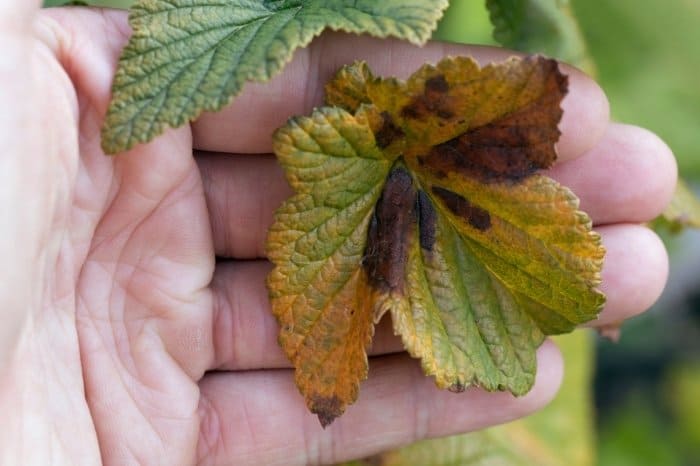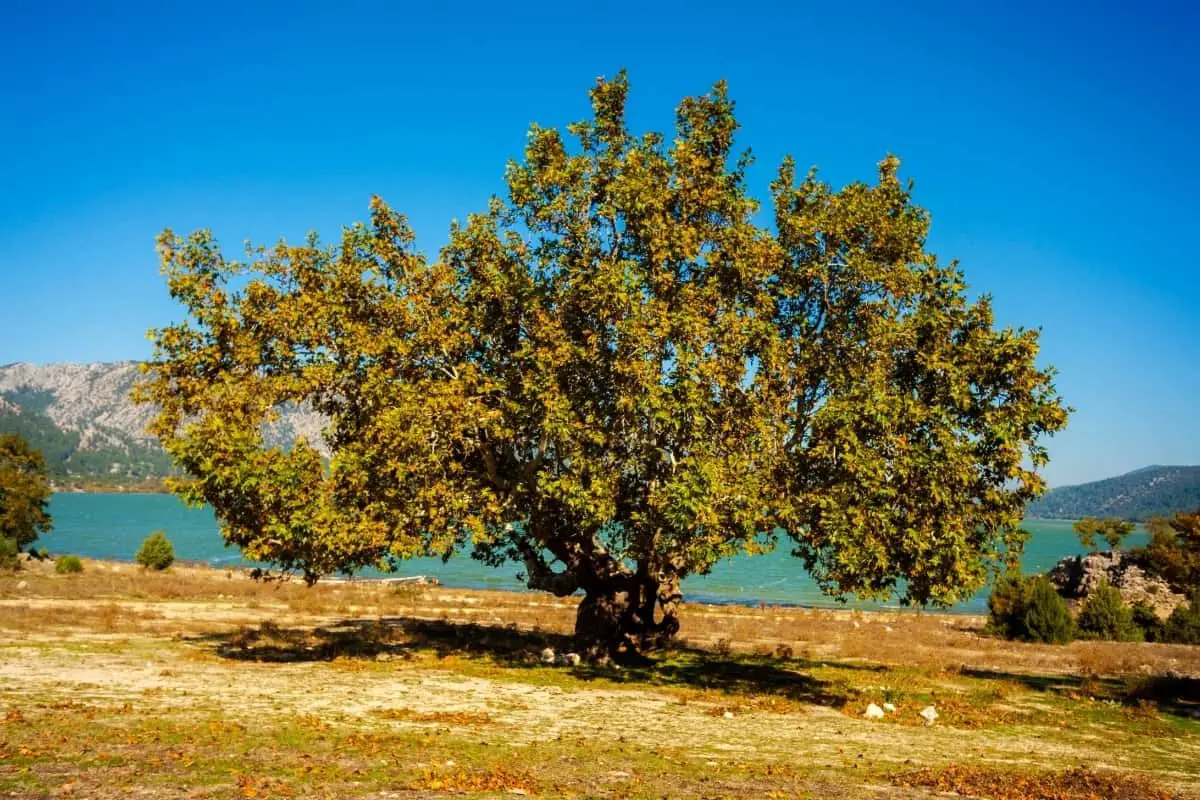Last Updated on January 22, 2022 by
Do you know how fast do sycamore trees grow before you chose to grow one? This information will help you as you plan your way around growing this tree.
The sycamore tree is the biggest deciduous tree in the Eastern United States growing as tall as 75 to 100 feet tall. Similar to oaks, and maples, they are a common tree. Sycamore is easy to identify by their large, light green leaves and their massive shape as well as their distinctive-looking bark.
This tree does well in USDA zones 4 through 9 and produces seeds after a long time probably by age 250 years. The sycamore tree sheds lots of leaves during the fall turning the light-green leaves into spectacular hues of yellow, red, and gold.
The leaves litter the ground around the plant with color but some people dislike it because of this mess. As the tree ages, the branches of the sycamore tree feature a light grey or white-colored bark that mottles as the tree ages. Older sycamore trees have a more mature look with the bark beginning to turn reddish-brown over time.
How Fast Does A Sycamore Tree Grow?
The sycamore tree grows very fast, more than 2 feet a year, and is highly tolerant to harsh environmental conditions. It develops robust root systems that anchor them firmly to the ground preventing them from being toppled over by strong winds.
Sycamore trees grow very high and last for many years but diseases can easily destroy them. If you don’t take of the sycamore tree it may never achieve its full potential.
Even though they are destroyed by diseases easily, they are easy to propagate from cuttings and to grow. If you happen to have enough room in your garden, go ahead and plant this tree. But if you have limited space, don’t grow it because it will fill your entire garden within a short while. Sycamore has aggressive roots that grow deep and wide. Avoid growing it near homes, patios, driveways, or walls.
This tree demands lots of garden maintenance when it matures because it drops lots of leaves over winter and twigs throughout the year. Investing in a leaf blower is a good idea to help with the cleaning.
Find Out The 5 Best High CFM Leaf Blowers
How Can You Protect Your Sycamore Tree From Bad Weather?
Old sycamore trees become resilient even to the poor weather and snow. They can take anything from hurricane winds to storms and even heavy frost. But before they are mature, you have to protect the young trees from the harsh weather. There are a few ways to protect young sycamore, they include:
- Spread a 2-inch mulch layer around the base of the tree when the weather begins to turn cold. The mulch is good in providing more nutrients to the soil and retaining moisture. The mulch also acts as a pest deterrent protecting your sycamore tree from pests and diseases.
Pine Bark Mulch, 100% Natural Pine Bark Mulch
- Wrap burlaps around the tree when the snow starts to fall to keep them warm.
- If young sycamore trees experience temperatures lower than -34 degrees F, they will die. If you live in the far Northern states you will need to prepare young trees well in advance so they can make it through winter.
- Harsh winds also dry out the young sycamore so provide a cover for them or plant evergreen conifers around the sycamore for protection.
What Pests And Diseases Affect The Sycamore Trees As It Grows?
Now that we mentioned that the tree faces diseases and pests that are threatening, let see what type of diseases and pests.
Anthracnose – The most common disease-threatening sycamores all over the East Coast is Anthracnose. If the springtime has a lot of rain and cold weather, the Anthracnose will begin to develop n your trees. This disease looks like large cankers sunken into the bark of the tree appearing on the trunk and branches. As this infection spreads it kills the buds resulting in the development of a witch’s broom.
If this disease continues to spread unmanaged, the leaves begin to mottle and turn brown. It sheds its foliage prematurely and might suffer malnutrition causing it to die. To eliminate this disease, collect all the leaves that fall from the tree and destroy them. Never use these leaves for compost as the pathogens will overpower the organic matter.

Other common pests and diseases affecting these trees include:
- Bacterial leaf scorch
- Aphids
- Canker stain
Use Neem oil to keep bugs away from your tree throughout spring and summertime.
FAQs
Are sycamore trees easy to grow?
I have a few Sycamore Trees in my yard, and they're doing fine. I've had them for a few years now. The only thing I can say is that the soil should be well-drained. They don't like to sit in water.
Are sycamore trees good for yards?
The answer to this question depends on how you define "good for yards." There are many types of sycamore trees that can be planted in yards. Some are fast-growing, some are slow-growing and some are dwarf varieties. In general, the bigger the tree, the more shade it will provide. The problem is that larger trees have roots that spread over a wider area.
This makes it harder for them to survive in dry soils, especially those with poor drainage. Also, larger trees need more space than smaller trees, so they usually take up more room in your yard. If you are planting a tree in a container or pot, make sure that you place the tree where you want it to grow before you plant it. This will give the tree a good root system and help it become established quickly.
Do sycamore trees have deep roots?
A sycamore tree (Platanus occidentalis) has some very large roots that go down pretty far into the ground. The top of the roots are about 2 feet above the surface, and grow straight down from the trunk. Roots go into the ground at an angle, and they are very long and thick.
Can you grow a sycamore tree from a branch?
es, and here's how... What do I need to grow my own sycamore tree? You can grow your own sycamore tree from a branch in the autumn. The tree can be planted in a pot or in the ground. It takes at least three years for the tree to grow into a decent-sized specimen.
Sycamores are native to Europe, Asia, and North America. They like damp soils with plenty of sunshine. In the wild, sycamores are often found near streams and ponds. They can reach 30 feet tall and live for hundreds of years. Sycamore trees are easy to care for.
Are sycamore trees wind resistant?
The answer to your question is yes, they are. Sycamore trees are very wind resistant and are often used for windbreaks. The reason that they are so wind resistant is because of their thick bark.
How big is the biggest sycamore tree?
The largest living sycamore in the United States, at least in terms of its trunk size, is located in the middle of a forested area in the middle of the state of Ohio. It’s one of two trees on this list that was measured to be over 100 feet tall. The second largest living sycamore is located in the town of St. Marys, Pennsylvania.
When it comes to diameter, the largest living sycamore is in the city of Lake Forest, Illinois. The tree, known as “The Great Sycamore,” is estimated to be around 90 feet tall and around 88 feet across. This tree, which is still alive today, is also the tallest and widest sycamore on record in the United States.
Sycamore Tree Growth Conclusion
FAQs
Are sycamore trees easy to grow?
I have a few Sycamore Trees in my yard, and they're doing fine. I've had them for a few years now. The only thing I can say is that the soil should be well-drained. They don't like to sit in water.
Are sycamore trees good for yards?
The answer to this question depends on how you define "good for yards." There are many types of sycamore trees that can be planted in yards. Some are fast-growing, some are slow-growing and some are dwarf varieties. In general, the bigger the tree, the more shade it will provide. The problem is that larger trees have roots that spread over a wider area.
This makes it harder for them to survive in dry soils, especially those with poor drainage. Also, larger trees need more space than smaller trees, so they usually take up more room in your yard. If you are planting a tree in a container or pot, make sure that you place the tree where you want it to grow before you plant it. This will give the tree a good root system and help it become established quickly.
Do sycamore trees have deep roots?
A sycamore tree (Platanus occidentalis) has some very large roots that go down pretty far into the ground. The top of the roots are about 2 feet above the surface, and grow straight down from the trunk. Roots go into the ground at an angle, and they are very long and thick.
Can you grow a sycamore tree from a branch?
es, and here's how... What do I need to grow my own sycamore tree? You can grow your own sycamore tree from a branch in the autumn. The tree can be planted in a pot or in the ground. It takes at least three years for the tree to grow into a decent-sized specimen.
Sycamores are native to Europe, Asia, and North America. They like damp soils with plenty of sunshine. In the wild, sycamores are often found near streams and ponds. They can reach 30 feet tall and live for hundreds of years. Sycamore trees are easy to care for.
Are sycamore trees wind resistant?
The answer to your question is yes, they are. Sycamore trees are very wind resistant and are often used for windbreaks. The reason that they are so wind resistant is because of their thick bark.
How big is the biggest sycamore tree?
The largest living sycamore in the United States, at least in terms of its trunk size, is located in the middle of a forested area in the middle of the state of Ohio. It’s one of two trees on this list that was measured to be over 100 feet tall. The second largest living sycamore is located in the town of St. Marys, Pennsylvania.
When it comes to diameter, the largest living sycamore is in the city of Lake Forest, Illinois. The tree, known as “The Great Sycamore,” is estimated to be around 90 feet tall and around 88 feet across. This tree, which is still alive today, is also the tallest and widest sycamore on record in the United States.
Even if this tree is low maintenance, you need to keep an eye on it to ensure it grows well. If the rain is too much, be sure to check for mold signs and disease when the weather clears because this can kill the tree very fast.
Caroline is a gardener who loves to get down to the nitty–gritty of gardening. She proudly proclaims herself as a ‘dirt worshipper‘ and can often be found deep in the garden, covered in soil and singing to her plants. As a self–proclaimed ‘plant whisperer‘, Caroline believes that plants need love and attention just like any other living thing, and she loves to give them both. When she‘s not tending to her garden, you can often find her researching the latest gardening trends, or teaching others how to make their gardens thrive



